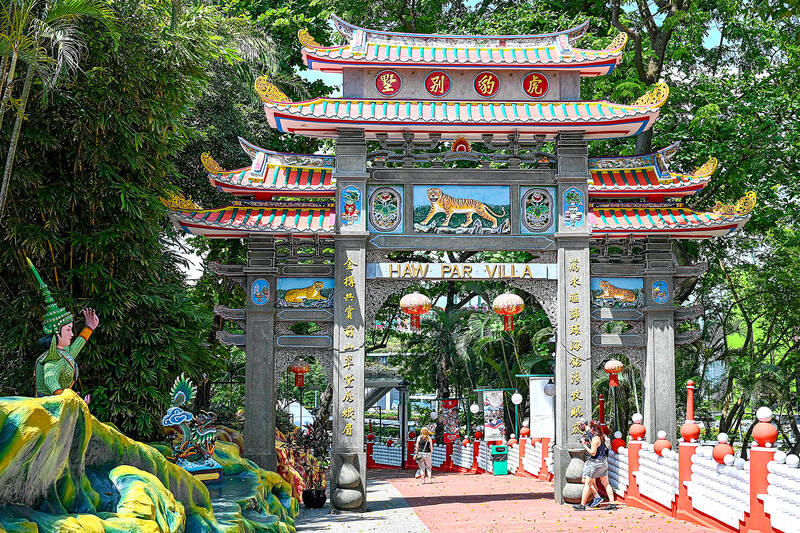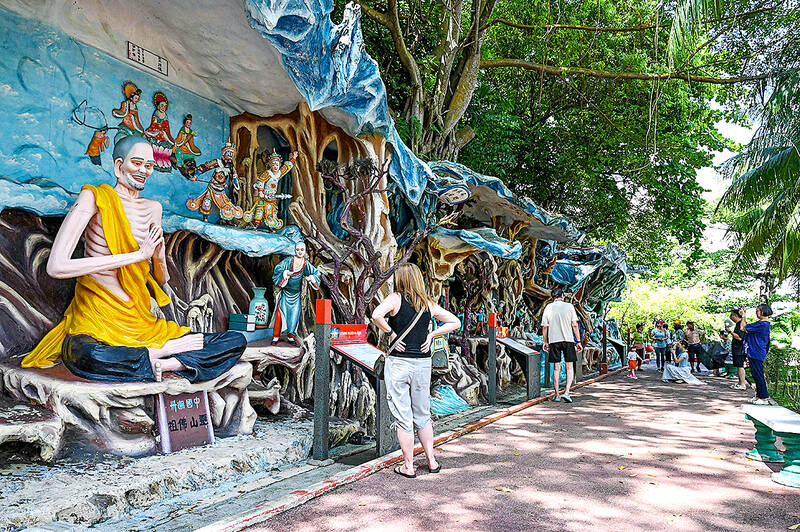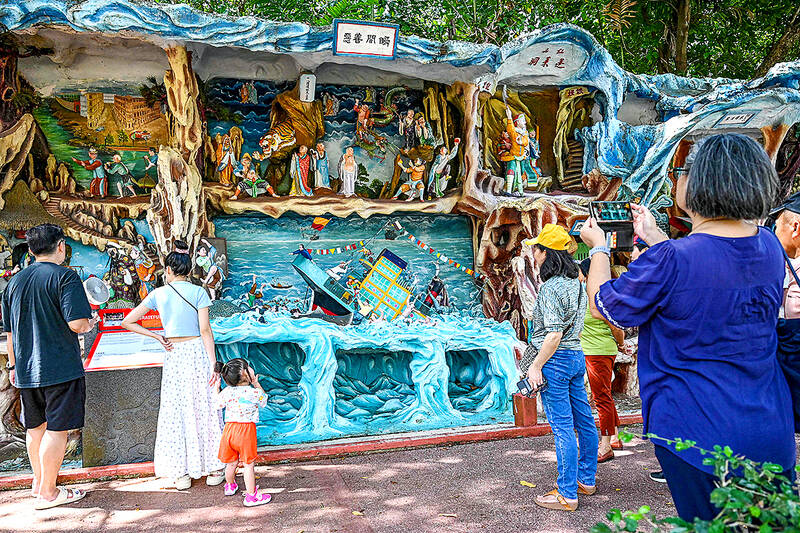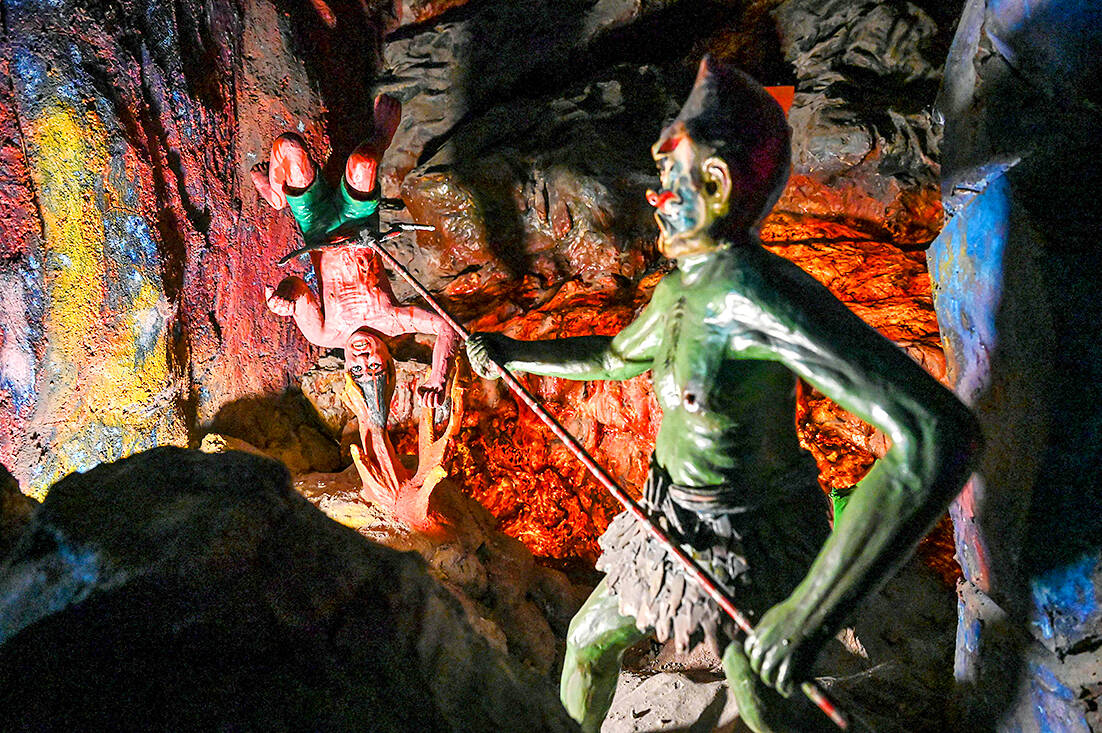Gory grottos with demons impaling sinners on stakes and people drowning in a pool of blood are not part of your average theme park experience.
But at Hell’s Museum in Singapore, the main attraction at the Haw Par Villa park, visitors are welcomed to a kitschy, air-conditioned hell on Earth.
Inside the sprawling park complex with over 1,000 statues and dioramas showcasing Asian culture, faiths and philosophy, Hell’s Museum exhibits various religious views on the afterlife.

Photo: AFP
Visitors are encouraged to learn about the 10 Courts of Hell through intense depictions of punishments for earthly sins.
At court number two, for instance, corruption gets you frozen in ice while rapists at court seven are thrown in boiling oil.
The 10 Courts of Hell are “the result of the mixing of four different religions and philosophies: Buddhism, Taoism, Hinduism, Confucianism,” said Eisen Teo, the chief curator of Hell’s Museum in the multicultural city-state.

Photo: AFP
“The sculptures and dioramas are a visual dissection of many classics, stories and moral values that many Singaporeans have and are familiar with,” Teo said.
Visitor Gin Goldberg said she wasn’t so surprised to learn that many religions had differing opinions on the afterlife.
“One person’s heaven would be another person’s hell,” the American said.

Photo: AFP
PARTY IN HELL
The odd park stands apart from gleaming Singapore’s mainstream tourist attractions such as the luxury shops of Marina Bay Sands or the towering “supertrees” of Gardens by the Bay.
Haw Par Villa was built in 1937 by entrepreneur Aw Boon Haw, known for co-developing Asia’s much-loved Tiger Balm pain relief rub.

Photo: AFP
While fondly remembered by older generations, the park has had trouble attracting the Gen Z crowd and younger millenials, according to Journeys, the firm that manages the park.
To broaden appeal, it has held several rave parties and other private events — but not too near to religious exhibits.
“After they came here (for the parties) they fell in love with the quirky, eccentric park, with these cool sculptures. Fell in love with them and they keep doing repeat visits,” said Savita Kashyap, Journeys’ executive director.
While Haw Par Villa isn’t just about the afterlife, and raves — it also displays scenes from Chinese folklore such as “Romance of the Three Kingdoms” — its hellish attraction remains the top draw.
But not for all.
One Filipina visitor said while leaving that she won’t be returning anytime soon.
“It’s very scary,” she said.

June 2 to June 8 Taiwan’s woodcutters believe that if they see even one speck of red in their cooked rice, no matter how small, an accident is going to happen. Peng Chin-tian (彭錦田) swears that this has proven to be true at every stop during his decades-long career in the logging industry. Along with mining, timber harvesting was once considered the most dangerous profession in Taiwan. Not only were mishaps common during all stages of processing, it was difficult to transport the injured to get medical treatment. Many died during the arduous journey. Peng recounts some of his accidents in

“Why does Taiwan identity decline?”a group of researchers lead by University of Nevada political scientist Austin Wang (王宏恩) asked in a recent paper. After all, it is not difficult to explain the rise in Taiwanese identity after the early 1990s. But no model predicted its decline during the 2016-2018 period, they say. After testing various alternative explanations, Wang et al argue that the fall-off in Taiwanese identity during that period is related to voter hedging based on the performance of the Democratic Progressive Party (DPP). Since the DPP is perceived as the guardian of Taiwan identity, when it performs well,

A short walk beneath the dense Amazon canopy, the forest abruptly opens up. Fallen logs are rotting, the trees grow sparser and the temperature rises in places sunlight hits the ground. This is what 24 years of severe drought looks like in the world’s largest rainforest. But this patch of degraded forest, about the size of a soccer field, is a scientific experiment. Launched in 2000 by Brazilian and British scientists, Esecaflor — short for “Forest Drought Study Project” in Portuguese — set out to simulate a future in which the changing climate could deplete the Amazon of rainfall. It is

The Taiwan People’s Party (TPP) on May 18 held a rally in Taichung to mark the anniversary of President William Lai’s (賴清德) inauguration on May 20. The title of the rally could be loosely translated to “May 18 recall fraudulent goods” (518退貨ㄌㄨㄚˋ!). Unlike in English, where the terms are the same, “recall” (退貨) in this context refers to product recalls due to damaged, defective or fraudulent merchandise, not the political recalls (罷免) currently dominating the headlines. I attended the rally to determine if the impression was correct that the TPP under party Chairman Huang Kuo-Chang (黃國昌) had little of a